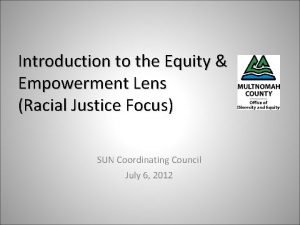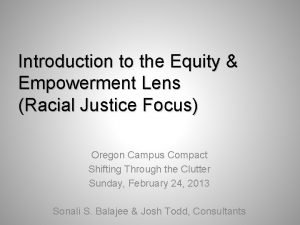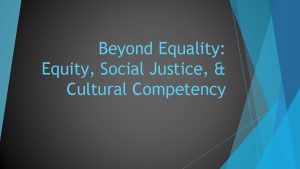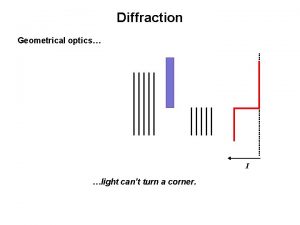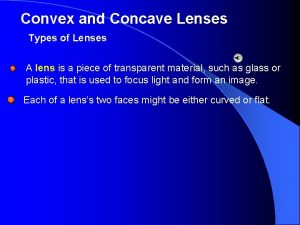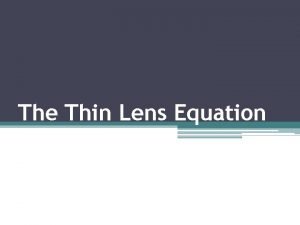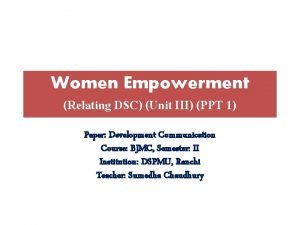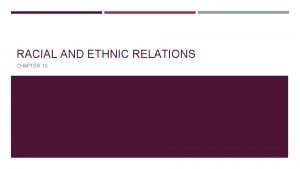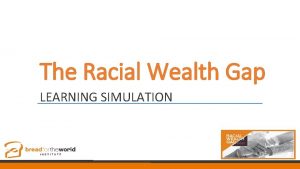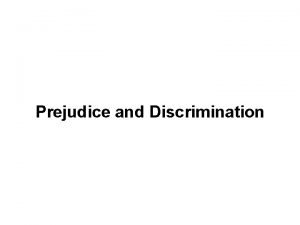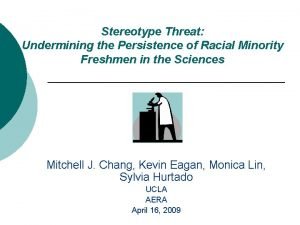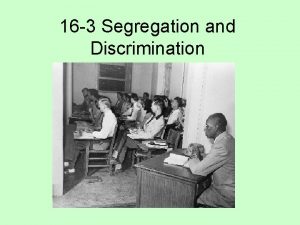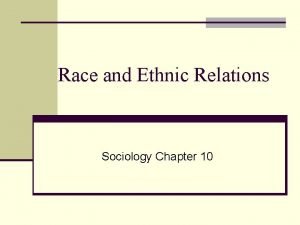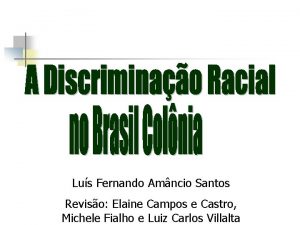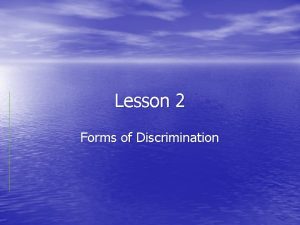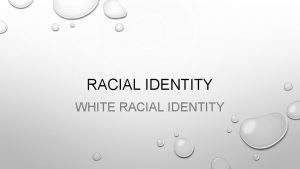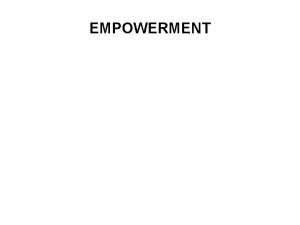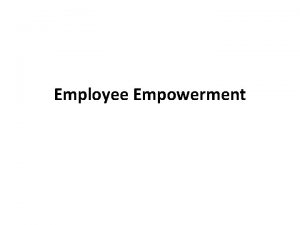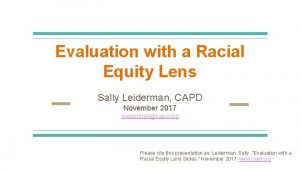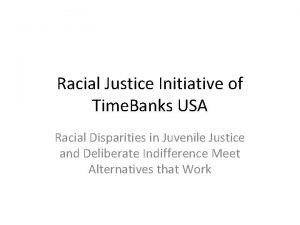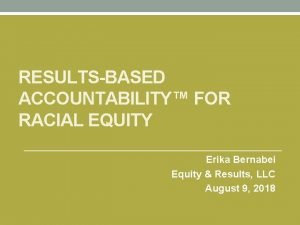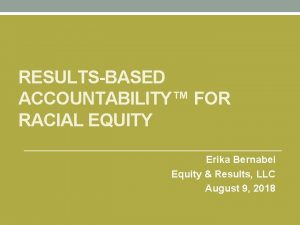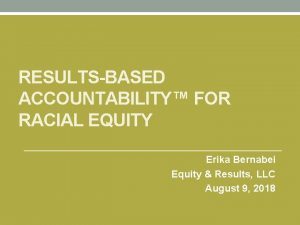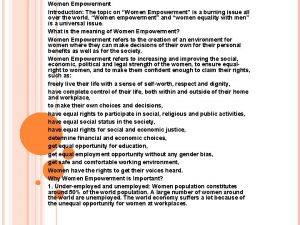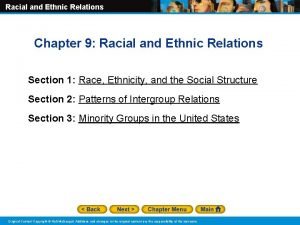Introduction to the Equity Empowerment Lens Racial Justice























- Slides: 23

Introduction to the Equity & Empowerment Lens (Racial Justice Focus) SUN Coordinating Council July 6, 2012

Purpose of Presentation: Basic education on history of Lens, foundational models and definitions, racial justice focus, focusing on definitions of ‘diversity’ 2

"To raise new questions, new possibilities, to regard old problems from a new angle, requires creative imagination and marks real advance in science. ” --Albert Einstein 3

How are Health and Positive Community Outcomes Connected to Social Justice? • Health and positive community outcomes are basic human needs • Human development is dependent on health Source: Tackling Health Inequities through Public Health Practice: Theory to Action (2010) Richard Hofrichter and Rajiv Bhatia

How are Health and Positive Community Outcomes Connected to Social Justice? • Health inequities are health disparities that result from preventable, systemic conditions, policies, and institutional practices • Action to eliminate inequities requires a perspective and a conceptual framework grounded in principles of social justice

SUN System Outcomes • • • Children Ready to Enter School (0 -5 years) Academic Success Healthy Kids & Families Prosperity Desirable places to live

Why Are We Focusing on Race / Ethnicity? • The SUN Service System (SUN) vision is for a system that realizes the potential of those served through inclusive access to an array of effective services and initiatives delivered through a collaborative approach and integrated across agencies, jurisdictions and funders. • Racial and ethnic inequities prevent our organization and community from fulfilling our overall potential • We move toward our vision by eliminating the root causes of such inequities

Why Are We Focusing on Race / Ethnicity? • We have made strides in reducing some health inequities in recent years, but research still shows: • Overall, people of color have worse outcomes than Whites in Oregon. • In Oregon, Blacks / African Americans are significantly more likely than Whites to die from heart disease, stroke, diabetes, and cancer. • Imperative to address inequities with the greatest prevalence

A Few Key Definitions • Quality Improvement: Continuous and ongoing effort to achieve measurable improvements in efficiency, effectiveness, performance, accountability, outcomes, and other indicators of quality in services or processes which achieve equity and improve the health of the community. Source: Journal of Public Health Management and Practice, 2010, 16(1), 5 -7.

“In every work of genius, we recognize our once rejected thoughts. “ Ralph Waldo Emerson 10

A Few Key Definitions • Equity: An ideal and a goal. --Ensures that everyone has the resources to succeed --Fair and just distribution of resources --Just decision-making and involvement processes, leading to greater shared power and involvement of communities most affected by inequities

A Few Key Definitions • Inequities: Systemic, avoidable, unfair and unjust differences in indicators of success

A Few Key Definitions • Root Causes: The underlying causes of health inequities, and include: --unjust decision-making; --disempowering engagement processes; --inequities in living and working conditions, access to transportation and proper food sources; and --racism, classism, and other forms of discrimination (sexism, homophobia, ableism, ageism, etc. )

A Few Key Definitions • Empowerment: A social-action process in which individuals and groups act to gain mastery over their lives in the context of changing their social and political environment. Source: Wallerstein, 1992

A Few Key Definitions • Racism: *Conduct, words, or practices which advantage or disadvantage people because of their culture, ethnic origin, language, or color. *It is just as damaging in obvious forms as it is in less obvious and subtle forms, and is still called racism whether intentional or unintentional. Source: United Nations general reports as well as Learning / Teaching Scotland (www. ltscotland. org. uk/raceequality)

A Few Key Definitions • Racism, continued: “Only members of the dominant social group can exhibit racism because racism is prejudice plus the institutional power to enforce it. ” Source: American Medical Students Association, Power & Privilege Definitions. www. amsa. org/AMSA/. . . /Power_Privilege_Definitions. sflb. ashx 16

A Few Key Definitions • Structural Racism: “…a system in which public policies, institutional practices, cultural representations, and other norms work to reinforce and perpetuate racial group inequity. It identifies dimensions of our history and culture that have allowed privileges associated with ‘whiteness’ and disadvantages associated with ‘color’ to endure and adapt over time. ” Source: Policy. Link, 2011 17


Causes of Health Inequities Root Factors Poverty Discrimination Immigration status Institutional power --the ‘-isms’ Upstream Neighborhood Conditions Toxic contaminants Joblessness Unequal education Poor transportation Inadequate access to food and exercise Marketing of unhealthy products Unhealthy housing Land use Access to healthy food Voter participation Risk Behaviors Nutrition Physical activity Tobacco use Alcohol use Violence Hopelessness Disease, Injury, Mortality Infectious disease Chronic disease Injury Infant mortality Life expectancy Funding for • Health Care Services • Health Education • Individual Services Downstream Adapted from: Prevention Institute. The Imperative of Reducing Health Disparities through Prevention: Challenges, Implications, and Opportunities, October, 2006.

Solutions to Health Inequities Root Factors Poverty Racial discrimination Immigration status Institutional power --the ‘-isms’ Neighborhood Conditions Toxic contaminants Joblessness Unequal education Poor transportation Inadequate access to food and exercise Risk Behaviors Nutrition Physical activity Tobacco use Alcohol use Violence Hopelessness Disease, Injury, Mortality Infectious disease Chronic disease Injury Infant mortality Life expectancy Resources for • Community capacity-building • Policy advocacy • Social and economic policy change • Dismantling institutional privilege training Upstream Downstream Adapted from: Prevention Institute. The Imperative of Reducing Health Disparities through Prevention: Challenges, Implications, and Opportunities, October, 2006.

Relational Worldview Model Values: Balance Inclusion Systems Empowerment Relationship CONTEXT MIND Sustainability Connects: SPIRIT BODY Land Resources People Shared power Spirit and 21 purpose

Why an Equity AND Empowerment Lens? • Equity is an ideal and a goal, not a process • Connection to definition of equity: improved and just distribution of resources and voice / power • Individual, organizational, and community empowerment are the means to achieving equity • Keeps critical thinking about the social, economic, and environmental context at the forefront

We are better together! For more information, contact: Sonali S. Balajee, Senior Policy Advisor On the Equity and Empowerment Lens sonali. s. balajee@multco. us 503 -988 -4008
 Equity and empowerment lens
Equity and empowerment lens Equity and empowerment lens
Equity and empowerment lens Equality equity justice fence
Equality equity justice fence Lens formula
Lens formula Fresnel lens vs convex lens
Fresnel lens vs convex lens Concave lens
Concave lens Optics equation
Optics equation Women empowerment definition
Women empowerment definition Jim crow laws in what region or regions did it exist
Jim crow laws in what region or regions did it exist Timid bigot example
Timid bigot example Chapter 10 racial and ethnic relations
Chapter 10 racial and ethnic relations Black studies and the racial mountain
Black studies and the racial mountain Racial wealth gap simulation
Racial wealth gap simulation Promoting racial literacy in schools
Promoting racial literacy in schools Racial theories apush
Racial theories apush Racial prejudice
Racial prejudice Symbolism of noli me tangere
Symbolism of noli me tangere Racial insults
Racial insults In what region did racial etiquette exist
In what region did racial etiquette exist Cartel ley organica contra la discriminacion racial
Cartel ley organica contra la discriminacion racial Chapter 10 racial and ethnic relations review worksheet
Chapter 10 racial and ethnic relations review worksheet Democracia racial
Democracia racial Lesson 2: racial discrimination
Lesson 2: racial discrimination Transgender economic empowerment project
Transgender economic empowerment project
